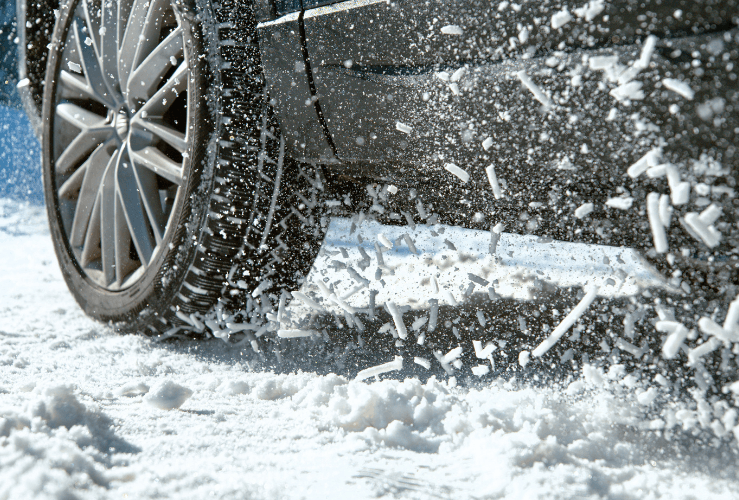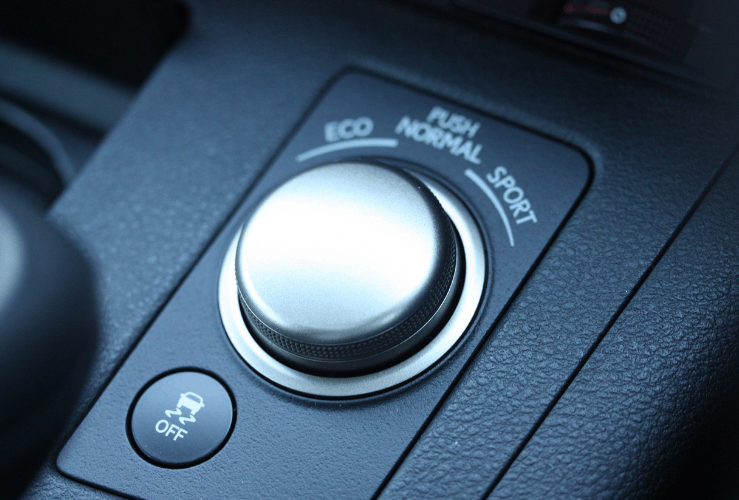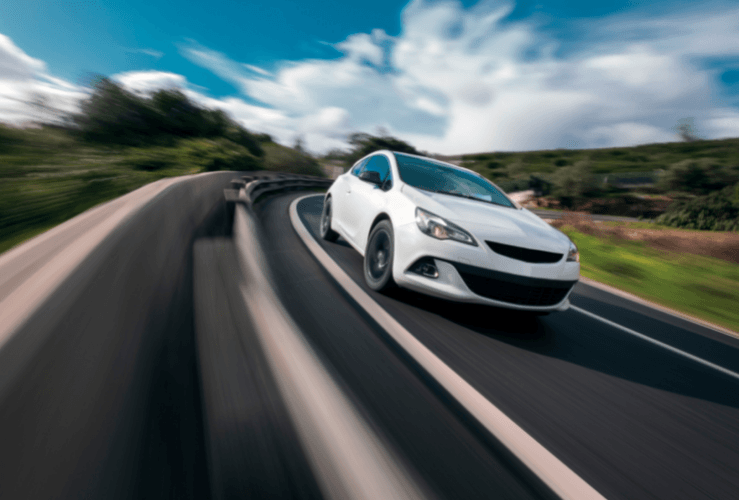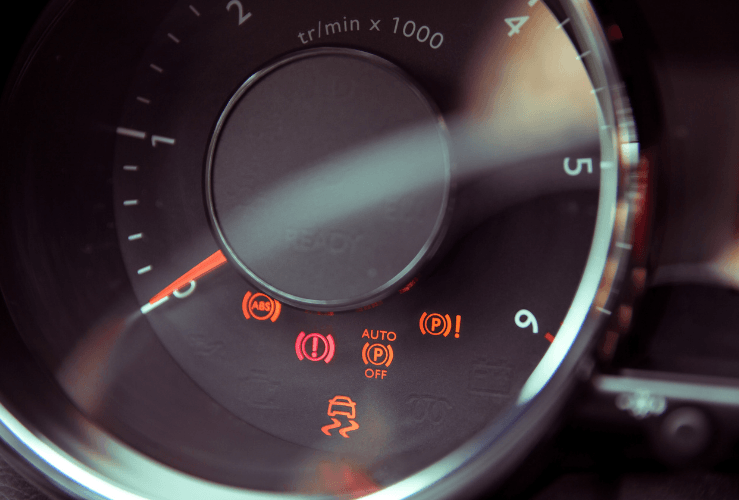What is traction control?
Traction control is one of the most important safety systems in your car.
This active safety feature helps your vehicle maintain traction with the roads surface, to limit your wheels spinning.
Here we’ll explain how it works.

What does traction control do?
Your vehicle's traction control system helps maintain drive power and prevent your wheels slipping on mud, ice, sand, or dirt, by sensing the acceleration of each wheel.
The traction control system can also help reduce or eliminate slipping/skidding while cornering.
How does traction control work?
If three wheels are moving as expected but one is slipping, traction control works with the ABS system to brake the slipping wheel, so that the vehicle can proceed safely.
The system pulses the brakes to slow down the slipping wheel, providing more overall traction on the road surface.
How to use traction control: Should you use traction control all of the time?
Traction control is undeniably a highly effective safety feature, but it might not be suitable to have switched on all the time.
Example of when traction control is not suitable
If you are stuck on a patch of mud or snow, you may need to rock the vehicle back and forth in order to gain traction. However, with traction control turned on, this is not possible.
This issue is further discussed below.
How do you switch traction control on and off?
Your traction control system is operated with a button with an icon of a car above wavy wheel tracks.
What does ‘TC’ mean on a car?
On some vehicles, the traction control on/off switch may simply be marked with a ‘TC’.
Most switches also feature a traction control light to show when the traction control system is in operation.
How to turn off traction control?
Simply press the traction control button so that it pops out and the light goes off.
If you are in any doubt as to the operation of your vehicle's traction control system, check the manual.
If you have lost the manual, you should be able to download a digital PDF version from the manufacturer.

Traction control history
The original, if primitive, version of the traction control system was the ‘limited slip differential’, which was introduced in the 1960s. However, this system could not completely eliminate wheel slippage.
Then the Buick Car Company introduced a more sophisticated computer-managed system that detected wheel slips and modulated engine power accordingly - way back in 1971.
Later, in 1979, a "traction monitoring system" was introduced by Cadillac.
Traction control characteristics: ECU & HCU
Operationally, the modern traction control system is similar to the anti-lock braking system (ABS).
The traction control system shares the wheel speed sensors, the electronic control unit (ECU) and the hydraulic control unit (HCU) with the anti-lock braking system (ABS).
How does the traction control system work in modern vehicles?
In modern vehicles, the ABS and the traction control are considered part of the same system.
The wheel speed sensors detect the speed of the wheel and communicate this to the ECU.
If the system determines that one wheel is spinning faster than the others, the ECU takes over the hydraulic control unit, then applies the brakes intermittently to control the slipping wheel. This then gives the vehicle more overall traction on slippery surfaces.
Wheel speed sensors on two-wheel-drive vehicles
In the case of two-wheel-drive vehicles, wheel speed sensors are usually only connected to the wheels receiving power.
Managing slippage with engine power
In some vehicles, the traction control system can manage wheel spin by reducing engine power. This can be effected either by:
● Retarding the ignition timing
● Reducing the fuel supply to the cylinders
● Closing the throttle
When any of the above happen, the driver may sense some pulsing vibrations through the acceleration pedal.

Improved cornering with traction control
Traction control systems can also help maintain control around corners.
How does traction control help improve cornering?
When cornering, the outer wheels spin faster than the inner wheels, because they have to cover more distance in the same time frame.
Without traction control, when the driver applies more throttle while cornering, the wheels may slide. However with traction control on, slipping wheels are controlled, preventing the vehicle from slipping/skidding.
When is traction control activate when cornering?
Traction control is activated when the speed of the wheels is mismatched with the overall acceleration of the vehicle.
When traction control is undesirable?
Standing starts
There are certain scenarios where traction control is not desirable. For example, if your vehicle is at a standstill on a slippery surface, traction control may reduce engine power to the degree that it is difficult to gain enough traction to move off.
In such circumstances, you can turn off the traction control.
What if I cannot turn off my traction control?
In some vehicles traction control cannot be completely deactivated, but it may permit an increase in wheelspin under such conditions as a standing start.
When to use traction control?
Wondering, should traction control should be on or off?
Whether or not you decide to use traction control may depend on your driving style, as well as:
● The weather conditions
● The quality of the road surface
● Type of tyres
● Whether you have front-wheel-drive, rear-wheel-drive, or all-wheel-drive
However, if in doubt, try moving off with traction control switched on.
Wheel spin: Front, rear and all-wheel-drive
In general, front-wheel-drive vehicles experience a higher degree of wheel spin than those with rear-wheel-drive (unless the rear-wheel-drive system in question has a high torque engine).
Vehicles with all-wheel-drive and traction control can get better traction on slippery surfaces.

Service traction control/traction control warning light
The ‘service traction control’ warning light will come on if the car detects a fault with any of the TCS apparatus - such as a damaged wheel speed sensor, or a problem with the ABS.
What happens if there is a fault in the traction control apparatus?
If any of these components are not working properly, the car’s traction control may not work properly - potentially putting you, your passengers and other road users in danger.
Launch control systems
Some premium vehicles feature launch control systems, which support a controlled, safe launch from standstill. However, these are normally only found in high performance/race/rally cars.
What is StabiliTrak?
You’ve possibly heard of StabiliTrak, but exactly what is StabiliTrak?
StabiliTrak is an 'electronic stability control' system closely related to the traction control system.
How does StabiliTrak work?
When a driver faces a sudden hazard on the road - such as an animal or another vehicle unexpectedly merging into your lane - there is a tendency to over-correct the steering, which can result in losing control of the vehicle.
Stabilitrak, developed by General Motors, is an electronic stability control system that can sense when this happens, and stabilise the vehicle by controlling the brakes, and if necessary, the engine power.
StabiliTrak sensors
As well as using wheel speed sensors on each wheel, Stabilitrak features a rotation rate sensor which measures the vehicle's lateral speed and centre-line rotation. It also features a steering wheel sensor that determines the driver's steering intention.
These sensors help the ECU work out if it needs to intervene in a particular situation.
Similar systems to StabiliTrak
Other carmakers have introduced systems that work in a similar way to StabiliTrak, such as Audi's electronic stability program (ESP), and Ford's AdvanceTrac.
ESC Recalls
In the late 90s, Mercedes deemed ESC such an important safety feature that it recalled 130,000 A-Class cars and retrofitted them with the system.
Electronic Stability Control (ESC) regulations
The European Union made ESC mandatory on all new vehicles in 2009.
In the United States, the inclusion of ESC in all new vehicles has been mandatory since 2012.
Traction Control – Frequently asked questions
Why is my traction control light on?
If the traction control warning light briefly illuminates when you are driving, it means that the system is actively working to prevent wheelspin.
If the traction control warning light is constantly displayed on your dashboard it means you’ve either turned the car’s traction control off, or the system has suffered some kind of failure, in which case you should seek to get the issue resolved by a trained mechanic as soon as possible.
A permanently illuminated traction control warning light will also result in your car failing an MOT,
Find out what other dashboard warning lights mean.
Should I turn off traction control in rain?
The traction control system (TCS) system detects when a car’s wheel slips and loses its grip on the road.
It is therefore an important safety feature to have switched on in rain as it can help prevent your car from skidding or hydroplaning.
Does traction control use more fuel?
No, traction control should have no impact on fuel economy so it is ill advised to switch off you car’s traction control in an attempt to save fuel.
As an important safety feature in your car, you should have traction control switched on when you are driving.




